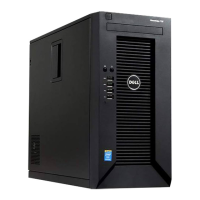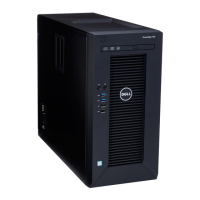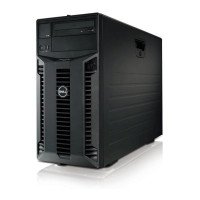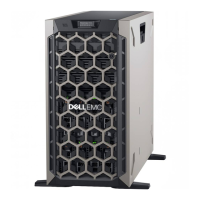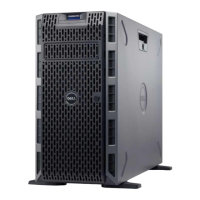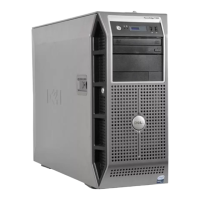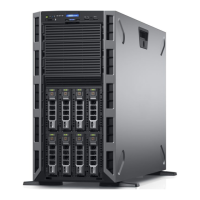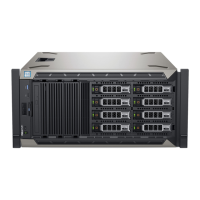Do you have a question about the Dell PowerEdge T20 and is the answer not in the manual?
Details about the front panel components like power button, USB, and audio connectors.
Explains the rear panel connectors, ports, and indicators for system connectivity.
Describes the LED indicators on the Network Interface Card (NIC) for network status.
Explains the diagnostic status indicated by the power supply's LED and self-diagnostic button.
Guides on installing the operating system and its configuration.
Lists the operating systems compatible with the system.
Provides links to additional resources and important notes for system users.
Instructions on how to access and navigate the system setup utility.
Describes the keyboard keys used for navigating within the System Setup utility.
Step-by-step guide for updating the system's BIOS.
Overview of various configuration options available in the System Setup.
Details on the Boot Manager screen and its options for boot device selection.
Explains the system and administrator password security features.
Procedures for setting up system and administrator passwords for security.
How to modify or remove existing system and administrator passwords.
Information about Intel Active Management Technology (AMT) for remote management.
Lists the necessary tools for installing system components.
Safety precautions and steps for opening and closing the system chassis.
Instructions for removing and installing the system bezel.
Details on the chassis-intrusion switch functionality and its installation.
An overview diagram showing the internal components of the system.
Steps for removing and installing the thermal sensor component.
Procedures for removing and installing the system's power switch.
Steps for removing and installing the system's front input/output panel.
Instructions for safely removing the hard-drive cage assembly.
Steps to install the hard-drive cage assembly into the system.
Guide to removing a 3.5-inch hard drive from its cage.
Guide to installing a 3.5-inch hard drive into its cage.
Guide to removing a 2.5-inch hard drive from its cage.
Guide to installing a 2.5-inch hard drive into its cage.
Steps for removing a 3.5-inch hard drive from the system's bay.
Steps for installing a 3.5-inch hard drive into the system's bay.
Procedure for detaching a hard drive from its carrier.
Procedure for attaching a hard drive to its carrier.
Information and procedures related to installing or removing an optical drive.
Detailed steps for removing the optical drive from the system.
Guidelines for installing memory modules to ensure proper system operation.
Examples of valid memory module configurations for the system.
Instructions and safety precautions for removing memory modules.
Step-by-step guide for installing new memory modules.
Procedures and safety notes for removing the system fan.
Steps for installing a new system fan.
Guidelines for installing PCI Express expansion cards.
Steps to safely remove an expansion card from its slot.
Steps to safely install a new expansion card into a slot.
Detailed instructions for safely removing the system processor.
Step-by-step guide for installing a new system processor.
Procedures for safely removing the system's power supply unit.
Steps for installing a new system power supply unit.
Instructions and warnings for replacing the system's CMOS battery.
Steps for safely removing the system board.
Step-by-step guide for installing a new system board.
Procedure to enter the system service tag after system board replacement.
How to interpret the power LED states for system diagnostics.
Explains the beep codes emitted during startup for memory issues.
Steps to resolve issues related to system startup failures.
Guidance on checking external cable connections for troubleshooting.
Steps to diagnose and resolve video subsystem problems.
Procedures for troubleshooting USB devices like keyboards and mice.
Steps to diagnose and resolve issues with serial port devices.
Guide to troubleshooting Network Interface Card (NIC) connectivity issues.
Steps to take if the system has been exposed to liquid.
Procedures for troubleshooting a system that may have suffered physical damage.
Steps to diagnose and resolve issues related to the system battery.
Guide to troubleshooting problems with the non-redundant power supply.
Identifies common causes of system overheating and cooling issues.
Steps to troubleshoot issues with the system fan.
Detailed steps for diagnosing and resolving memory-related problems.
Steps to troubleshoot issues with the optical drive.
Procedures for diagnosing and resolving hard drive problems.
Steps to troubleshoot issues with installed expansion cards.
Steps to diagnose and resolve processor-related issues.
Information on the ePSA diagnostics for hardware testing.
Explains the controls and menus within the system diagnostic utility.
Details on the system board jumper settings and their functions.
An illustration and list of various connectors on the system board.
Procedure to disable system passwords using the PSWD jumper.
Lists the supported processor types for the system.
Details about the expansion bus type and slots available.
Specifications for system memory architecture, sockets, and capacities.
Information about the types and number of hard drives supported.
Lists the available connectors on the back and front of the system.
Information about the integrated video capabilities.
Operating and storage conditions for temperature and humidity.
Lists common error messages and their descriptions.
Explains warning messages that alert users to potential problems.
Describes alert messages generated by system management software.
Information on how to contact Dell support for assistance.
Guidance on finding the system's unique service tag and express code.
Instructions for providing feedback on the documentation.
Details about the front panel components like power button, USB, and audio connectors.
Explains the rear panel connectors, ports, and indicators for system connectivity.
Describes the LED indicators on the Network Interface Card (NIC) for network status.
Explains the diagnostic status indicated by the power supply's LED and self-diagnostic button.
Guides on installing the operating system and its configuration.
Lists the operating systems compatible with the system.
Provides links to additional resources and important notes for system users.
Instructions on how to access and navigate the system setup utility.
Describes the keyboard keys used for navigating within the System Setup utility.
Step-by-step guide for updating the system's BIOS.
Overview of various configuration options available in the System Setup.
Details on the Boot Manager screen and its options for boot device selection.
Explains the system and administrator password security features.
Procedures for setting up system and administrator passwords for security.
How to modify or remove existing system and administrator passwords.
Information about Intel Active Management Technology (AMT) for remote management.
Lists the necessary tools for installing system components.
Safety precautions and steps for opening and closing the system chassis.
Instructions for removing and installing the system bezel.
Details on the chassis-intrusion switch functionality and its installation.
An overview diagram showing the internal components of the system.
Steps for removing and installing the thermal sensor component.
Procedures for removing and installing the system's power switch.
Steps for removing and installing the system's front input/output panel.
Instructions for safely removing the hard-drive cage assembly.
Steps to install the hard-drive cage assembly into the system.
Guide to removing a 3.5-inch hard drive from its cage.
Guide to installing a 3.5-inch hard drive into its cage.
Guide to removing a 2.5-inch hard drive from its cage.
Guide to installing a 2.5-inch hard drive into its cage.
Steps for removing a 3.5-inch hard drive from the system's bay.
Steps for installing a 3.5-inch hard drive into the system's bay.
Procedure for detaching a hard drive from its carrier.
Procedure for attaching a hard drive to its carrier.
Information and procedures related to installing or removing an optical drive.
Detailed steps for removing the optical drive from the system.
Guidelines for installing memory modules to ensure proper system operation.
Examples of valid memory module configurations for the system.
Instructions and safety precautions for removing memory modules.
Step-by-step guide for installing new memory modules.
Procedures and safety notes for removing the system fan.
Steps for installing a new system fan.
Guidelines for installing PCI Express expansion cards.
Steps to safely remove an expansion card from its slot.
Steps to safely install a new expansion card into a slot.
Detailed instructions for safely removing the system processor.
Step-by-step guide for installing a new system processor.
Procedures for safely removing the system's power supply unit.
Steps for installing a new system power supply unit.
Instructions and warnings for replacing the system's CMOS battery.
Steps for safely removing the system board.
Step-by-step guide for installing a new system board.
Procedure to enter the system service tag after system board replacement.
How to interpret the power LED states for system diagnostics.
Explains the beep codes emitted during startup for memory issues.
Steps to resolve issues related to system startup failures.
Guidance on checking external cable connections for troubleshooting.
Steps to diagnose and resolve video subsystem problems.
Procedures for troubleshooting USB devices like keyboards and mice.
Steps to diagnose and resolve issues with serial port devices.
Guide to troubleshooting Network Interface Card (NIC) connectivity issues.
Steps to take if the system has been exposed to liquid.
Procedures for troubleshooting a system that may have suffered physical damage.
Steps to diagnose and resolve issues related to the system battery.
Guide to troubleshooting problems with the non-redundant power supply.
Identifies common causes of system overheating and cooling issues.
Steps to troubleshoot issues with the system fan.
Detailed steps for diagnosing and resolving memory-related problems.
Steps to troubleshoot issues with the optical drive.
Procedures for diagnosing and resolving hard drive problems.
Steps to troubleshoot issues with installed expansion cards.
Steps to diagnose and resolve processor-related issues.
Information on the ePSA diagnostics for hardware testing.
Explains the controls and menus within the system diagnostic utility.
Details on the system board jumper settings and their functions.
An illustration and list of various connectors on the system board.
Procedure to disable system passwords using the PSWD jumper.
Lists the supported processor types for the system.
Details about the expansion bus type and slots available.
Specifications for system memory architecture, sockets, and capacities.
Information about the types and number of hard drives supported.
Lists the available connectors on the back and front of the system.
Information about the integrated video capabilities.
Operating and storage conditions for temperature and humidity.
Lists common error messages and their descriptions.
Explains warning messages that alert users to potential problems.
Describes alert messages generated by system management software.
Information on how to contact Dell support for assistance.
Guidance on finding the system's unique service tag and express code.
Instructions for providing feedback on the documentation.
| Chipset | Intel C226 |
|---|---|
| Storage Capacity | Up to 12TB |
| Power Supply | 290W |
| Form Factor | Tower |
| Processor | Intel Xeon E3-1225 v3 |
| Memory | Up to 32GB DDR3 |
| Storage Options | 4 x 3.5-inch SATA |
| RAID Support | RAID 0, 1, 5, 10 |
| Expansion Slots | 1 x PCIe x16 |
| Network | Gigabit Ethernet |
| USB Ports | 4 x USB 3.0 |
| Weight | 11 kg |
| Operating System Support | Windows Server, Red Hat Enterprise Linux |
| CPU Options | Intel Xeon E3-1200 v3 series, Intel Core i3, Intel Pentium |
